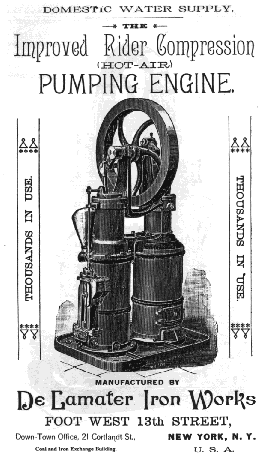
Alexander K Rider
 In 1838, Alexander Rider was put in charge of the foundry at the Phoenix Foundry, New York, owned by John Cunningham. Cunningham later sold his business to Messrs Hogg and De Lamater and the foundry renamed the Hogg & De Lamater Iron Works. Cornelius H. De Lamater was to eventually buy out his partner. It would seem that Rider left around this time to set a new partnership called Rider and Ward, at West 59th Street, although he retained his association with De Lamater. Around 1842 the Rider Engine Company was incorporated at Walden, New York.
In 1838, Alexander Rider was put in charge of the foundry at the Phoenix Foundry, New York, owned by John Cunningham. Cunningham later sold his business to Messrs Hogg and De Lamater and the foundry renamed the Hogg & De Lamater Iron Works. Cornelius H. De Lamater was to eventually buy out his partner. It would seem that Rider left around this time to set a new partnership called Rider and Ward, at West 59th Street, although he retained his association with De Lamater. Around 1842 the Rider Engine Company was incorporated at Walden, New York.
Sometime in the 1860s Riders son Thomas was apprenticed as a draughtsman with the De Lamater Iron Works. A. K. Rider had patented a automatic steam cut off for steam engines and his designs were built by several manufactures including the DeLamater Iron Works.
In 1871 Rider took out patents for improvements in Ericsson aspirating air engine, it was to the Phoenix Foundry that Ericsson had turned to build his air engines. These designs may not have been to successful as Rider went on to design an engine with two loaded pistons. In this design the pistons were of equal diameter but of unequal stroke set to run 90° out of phase. The main components of the new engine, were a cold compressing cylinder and a hot power cylinder, of longer stroke running in advance of the cold cylinder. The two cylinders were connected via a regenerator made up of thin iron plates.
The manufacture of this engine was taken up both in the U.S.A and U.K. In America the Delameter Iron Works sold the improved Rider Compression (Hot Air) Pumping Engine in six sizes, 4 inch, 4.25 inch, 5inch, 6inch, 8inch and 10inch. The Rider-Ericsson Engine Co., which took over from the De Lameter Iron Works and the Rider Engine Co., sold the Reco Rider engine in four sizes, 5 inch, 6 inch,8 inch and 10 inch. The engine was also built by the American Machine Co who sold the Denny Improved Rider Hot Air Pumping Engine in two sizes, 6 inch and 8inch.
In Britain the engine was built by Messrs Hayward-Tyler who had been introduced to the engine 1876 by Martin Benson, a dynamic American who had offices at 9 Southampton Buildings in Chancery Lane, London.
